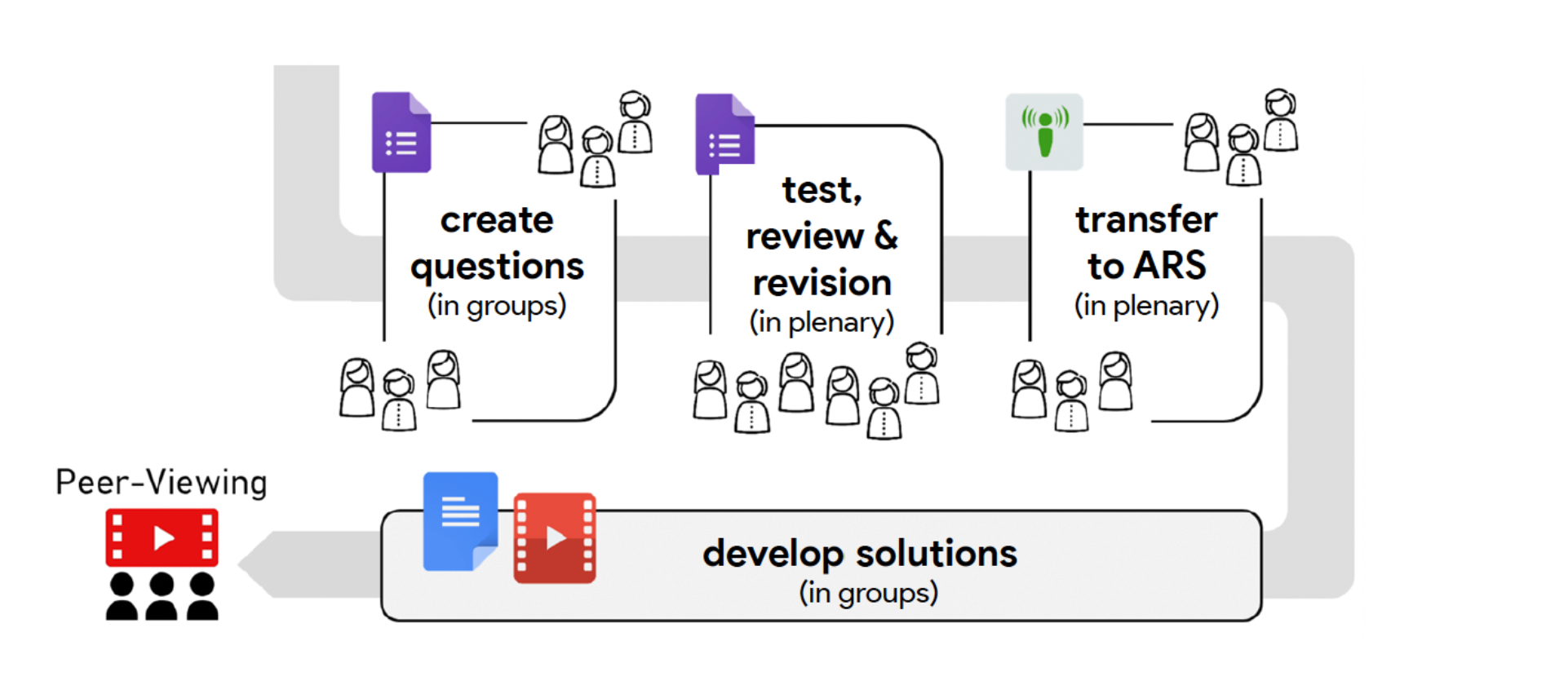#03 - Audience Response Systems
Didactic Implementation of Feedbackr & Co.
Already profitably used at Who wants to be a Millionaire?, Audience Response Systems (ARS) have been significantly developed and established in the educational sector. Originally ARS were developed to obtain viewer reactions, but today they are also used at universities and other institutions of higher education as a tool for enabling group feedback and interaction. Early ARS – the first was developed in the 1960s - were based on voltmeters. Students pressed a button on their seat and the teacher could use the volt number to read the students‘ reaction. These early ARS already showed first results, according to which the use of an ARS has positive effects on the retention performance of the students. The interaction in the lecture hall has also been proven to increase.1
For which group sizes are ARS suitable?
Especially with large groups or courses, it is difficult for the lecturer to include all participants. A short analogue survey by students raising their hands works for small seminars, but becomes a challenge in a lecture hall. The new digital possibilities of ARS are therefore indispensable for large events.
When to use ARS such as feedbackr?
- Constructive immanent feedback2 on presentations
Anonymous feedback allows for honest and detailed feedback on presentations or papers, so that both your students and you as a teacher can improve continuously. - Group discussions
For example, your students answer the same question before and after a group discussion. It is amazing how much the results can change! - Opinion polls
With feedbackr, you can make the personal opinions and assessments of your students visible. Thanks to the anonymity, students will likely answer honestly. - Structuring of the course schedule
Students appreciate being able to participate in the course or semester planning.
Just leave the choice of the next topic to the students. The right of co-determination increases the motivation of the students because they feel that they are heard. You can simply use the units you have already prepared for this purpose. - Exam preparation
Existing or missing knowledge can easily be made visible. Teachers can thus recognize what else should be taken into account. - Verification of understanding
feedbackr shows which topic areas are still unclear to students and should be explained in more detail.
The 75-25 rule:
Since students can see the result of an ARS poll without any time delay, the handling of wrong answers becomes a didactic focus. What can you do if not enough students chose the correct answer? The didactic ”75-25 Rule“ provides a rough guide for this scenario. Wrong answers that have been chosen by more than 25% of students should be discussed again in plenum. The same goes for correct answers that have been chosen by less than 75% of students.3

Exclusive tip from teaching at Graz University of Technology:
Get feedback throughout the whole course. To do so, leave a free text question open until the end of the course and check occasionally during the course whether a new question or comment has been added.
More suggestions for didactic application
lcebreaker questions at the beginning of the course
Ask your students a personal question at the beginning of your course, such as: What is the first term that comes to your mind when you think of topic/field XY? What do you see as the biggest challenge in topic/field XY right now? Have you gained any new insight (for you) into topic/field XY? What was it?
Peer instruction & ARS in combination
Lecturers have students first discuss the question in small groups, then each
student answers independently. This way students have the opportunity to
learn from peer instruction instead of learning the correct solution from the
teacher.
360° ARS – Student Generated Content with Audience Response Systems
This term refers to the project-like preparation of ARS questions by students. Students – not the teachers – are given the task of generating questions, answers and explanations on specific topics of the course. The teacher curates and examines the questions and selects suitable ones for the students of the next semester.

Web-based ARS for use in higher education
feedbackr was developed at Graz University of Technology.Further information on feedbackr input in the section Tools.
Kahoot is probably the most colorful ARS. It is well suited for playful knowledge checking due to its high scores and team mode. Teachers need a login, participants only the session lD. When logging in, a nickname is chosen which is later displayed in a high score list.
PINGO6 has different question types. Epecially the numeric question type is worth mentioning. Since PINGO is specifically designed for the peer instruction learning method, two question runs can be displayed next to each other to see the change in results. Teachers need a login, participants only the session ID.
Poll Unit digitizes the “dot voting method” (a form of cumulative voting): It helps to prioritize from a large number of options or ideas or to identify problems in the team through joint analysis. Neither teachers nor participants need an account.
Bibliography
1 Horowitz, Harold. “Interactivity in a Classroom Environment.” In: Sixth Conference on Interactive Instruction Technology for the Society of Applied Learning Technology. New York: IBM Corporate Education Center, 1988.
2 Pichler, Karin. Use-Cases in der (Hochschul-)Lehre (available in German).
3 and 4 Persike, Malte. So viele Antworten - Anleitung Audience Response Systeme in der Lehre. Hochschulforum Digitalisierung (available in German).
5 Universität Paderborn. PINGO in der Lehre. Didaktische Handreichung zu Einsatzmöglichkeiten (available in German).
Licensed under a Creative Commons License CC BY-SA 4.0
(except icons)

